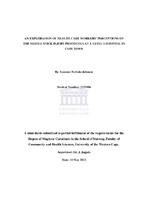| dc.description.abstract | Background: Health care workers who sustain needle stick injuries are at risk of
contracting blood-borne pathogens, e.g. Human Immunodeficiency Virus,Hepatitis B virus or Hepatitis C virus. Needle stick injuries are viewed as occupational hazards that can lead to health care workers developing acute or chronic diseases, which may lead to disability or death. Due to these healthrelated risks, health care workers are encouraged to adhere to universal precautions and standard operating procedures. In South Africa, the Occupational Health and Safety Act promulgated in 1993 required institutions draw up protocols in line with the regulations of the Act. However, if the health care workers do not comply with the protocols they may not be compensated for contracting a disease, e.g. Human Immunodeficiency Virus infection, following needle stick injuries. Aim: The aim of the study was to explore the health care workers’ perceptions of the needle stick injury protocol at a level 2 hospital in Cape Town. Research design: A qualitative approach was used to make sense of health care workers’ compliance to the protocols when sustaining a needle stick injury. An exploratory descriptive, contextual design was used to carry out an
in-depth investigation of the phenomenon. Sample: The study was done at Mowbray Maternity Hospital, a level 2 obstetric hospital in Cape Town. The researcher made use of convenience, purposive sampling. Semi-structured
interviews were used to collect the research data. Data collection: During the
data collection phase, ethical considerations towards participants were ensured
to include, among others, anonymity, autonomy and confidentiality of information. Data analysis: It included the following steps: reading and rereading,coding, displaying, reducing and interpreting the data. Findings: Some health care workers do not view sustaining a needle stick injury as risky enough to report the injury or even go for follow-up testing. This risky behaviour can have detrimental effects on their health. There is also a lack of knowledge about the institutional needle stick injury protocol. Recommendations: It is recommended to have educational and training sessions for all health care workers and new employees to familiarise them with the needle stick injury protocol and policies of the institution; to provide adequate management support 7 following work related injuries and to make health care workers aware of the consequences of non-compliance to institutional protocol. | en_US |

